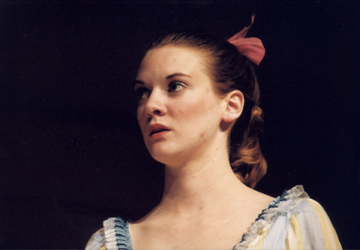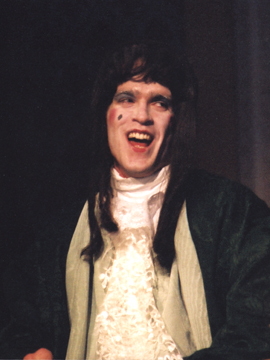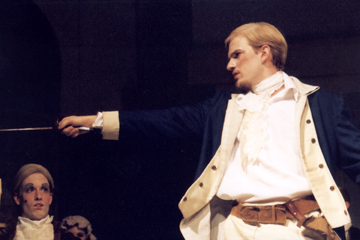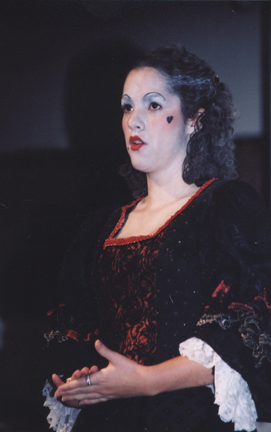The Gamester
by Susanna Centlivre
December 1, 2, 6, 8 and 9, 2001
Cast:
|
Male Roles:
|
| Box Keeper | Ross Brown |
| Valere | Jeremiah Burt |
| Galoon | David Crawford |
| Hector | Erich Dorzab |
| Count Cogdie | Dennis Huynh |
| Lovewell | Lance Ivy |
| Mr. Demurr | Lorin Koch |
| 1st Gentleman | Jarrod Lima |
| Marquis of Hazard | Adam Lombard |
| Dorante | Bradley Nelson |
| 2nd Gentleman | Fitch Venckeleer |
| Sir Thomas Valere | Tyler Webster |
| Porter | Kris Wilson |
|
|
Female Roles: |
Mrs. Security | Megan Daly |
| Betty | Nicole Ferguson |
| Angelica | Lindsey Lombard |
| Mrs. Topknot | Lorilea Mitchell |
| Maid | Cheri Rutan |
| Favourite | Erica Sharp |
| Lady Wealthy | Kristin Smith |
|
|
Crew:
|
Director | LuAnn Venden Herrell |
| Stage Manager | Dan Lounsbury |
| House Manager | Elizabeth Bruch |
| Assistant Directors | Elizabeth Bruch
Lindsey Lombard
Cherie Rutan
Erica Sharp |
| Lighting Design | Erich Dorzab |
| Lighting/Sound | Lorin Koch
Peter Hollister
Emily Yeo |
| Stage Design | Martha Mason (WWC Art Department) |
| Chief Costumer | Stephanie Binns
|
| Costumers | Elizabeth Bruch
Kurt Drechsel
Mari Ferguson
Cherie Rutan |
| Wardrobe Mistress | Megan Daly |
| Scenic Artist | Martha Mason (WWC Art Department) |
| Set Foreman and Design | Dr. Roy Campbell (WWC Physics Department) |
| Set Construction | Jeremiah Burt
John Campbell
Erich Dorzab
Andrea Dorzab
Jerry Entze
Bradley Nelson
Adam Lombard
Dan Lounsbury |
| Music Consultant | Dr. Kraig Scott (WWC Music Department) |
| Box Office | Doug Taylor
Adam Lombard> |
| Program and Poster Design | Tara Twing |
| Public Relations | Bradley Nelson |
Photos:








Rehearsal photos by Amanda Gibson
About the Play:
The Gamester was eighteenth-century woman dramatist Susanna Centlivre's first commercial success in 1705. It was written at the height of the Collier stage controversy--a widespread movement led by cleric Jeremy Collier for stage reform, in reaction to the sensational plays of the Restoration era. The play is one of the first iof a genre now known as "reform comedies": sometimes uneasily occupying middle ground between the earlier racy comedies of wit and the gentler sentimental comedies of the late 18th century; this type of play usually employs gentle satire and physical humor in an attempt to teach a social lesson. This approach is quite similar to hogarth's series of engravings entitles "The Rake's Progress." Many dramatists in the period 1698-1712 argued that the stage was a legitimate vehicle of presenting cautionary tales in a format that is both easily grasped and long remembered.
Centlivre, author of more than 16 plays, was in her time one of the most popular of dramatists. In terms of number of performances alone, her plays enjoyed longer runs than those of her now more familiar contemporaries Dryden, Congreve, Cibber, and sheridan; her works were included more often in the working reportories of the London companies. Her critical reputation was built on her skill at taking stock characters and situations and breathing new life and subtlety into them.
In the case of The Gamester, the play is a typical reform comedy that focuses on the necessary reclamation of a young nobleman who must be convinced of the dangers of gambling. What is not typical is the graphic illustration of everyone who must be convinced of the dangers of gambling. What is not typical is the graphic illustration of everyone who comes in contact with Valere is affected by his addiction, no matter their rank, gender, or philosophical outlook. His gambling causes a "ripple effect" that spreads outward, causing every other character to commit offenses against social station, manners, or morals. Also unusual is the method of Valere's reclamation: his fiancee', Angelica. She is an intelligent, sprightly agent of reform who brings Valere back within the boundaries of good society by the use of witty repartee and cunning masquerade.
November
29 Collegian Article
November
29 Collegian Review
November 23 Union-Bulletin Review (no longer available)
November
28 Review by Sarita McCaw
View
the Poster (designed by Tara Twing)
Back
to Drama History Page
last modified 25 June 03 by Bradley Nelson
Copyright © 2003 wwcdrama -- all rights reserved







